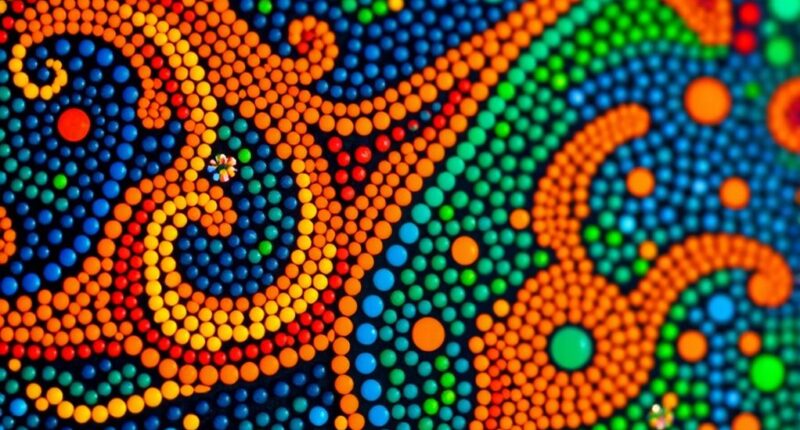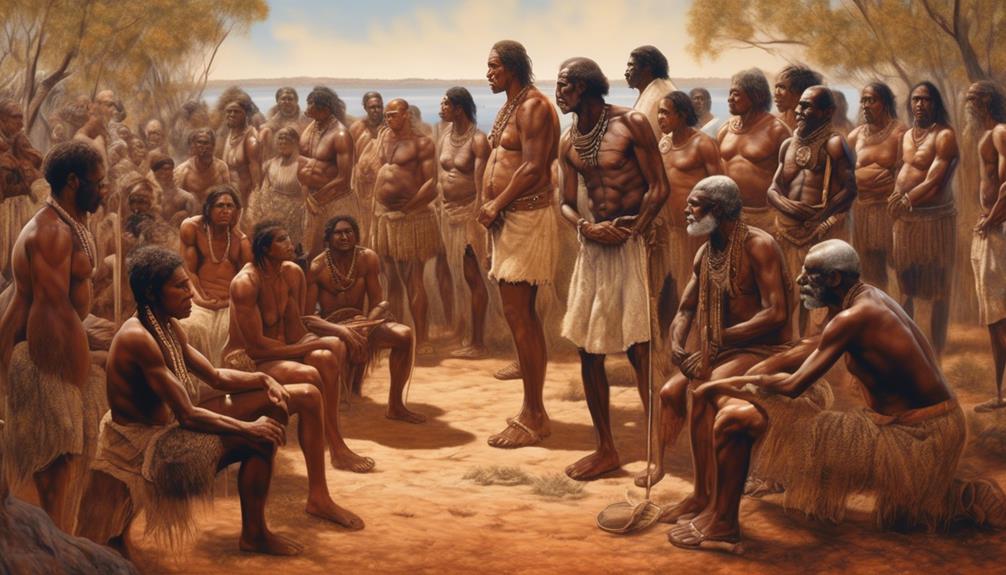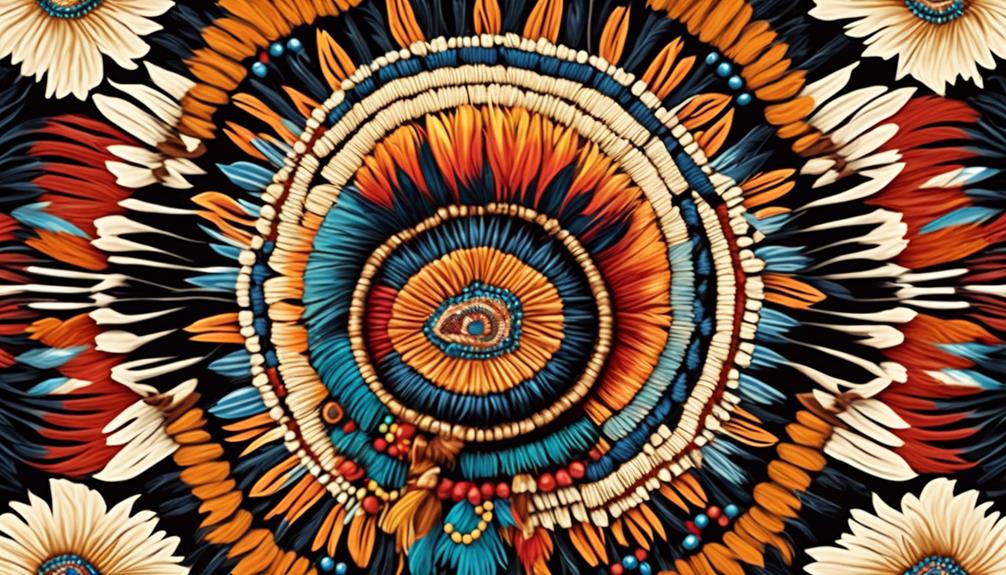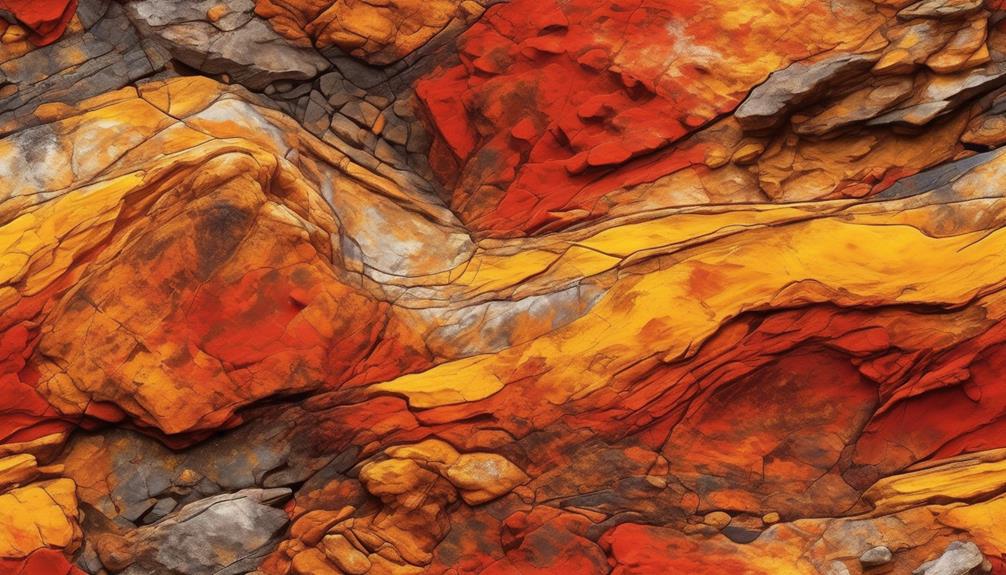Dot paintings are more than simple designs; they encode deep stories rooted in Indigenous culture. Each pattern, color, and symbol reflects Dreamtime stories, ancestral journeys, and sacred sites. Artists use dots to represent stars, footprints, waterholes, and spiritual beliefs, creating a visual language that connects land and tradition. By understanding these symbols, you can appreciate the richness and heritage woven into every artwork. Discovering the meaning behind the dots will reveal a world of cultural storytelling waiting to be explored.
Key Takeaways
- Dot paintings encode Dreamtime stories, spiritual beliefs, and ancestral journeys through symbols, colors, and patterns.
- The dots represent elements like stars or waterholes, serving as visual language for cultural narratives.
- Traditional techniques used natural pigments and tools like sticks or fingernails, evolving to acrylics for broader expression.
- The rhythmic patterns and meticulous detail reflect cultural storytelling, craftsmanship, and artistic innovation.
- These artworks symbolize a dialogue between tradition and modernity, preserving cultural heritage while embracing contemporary art.
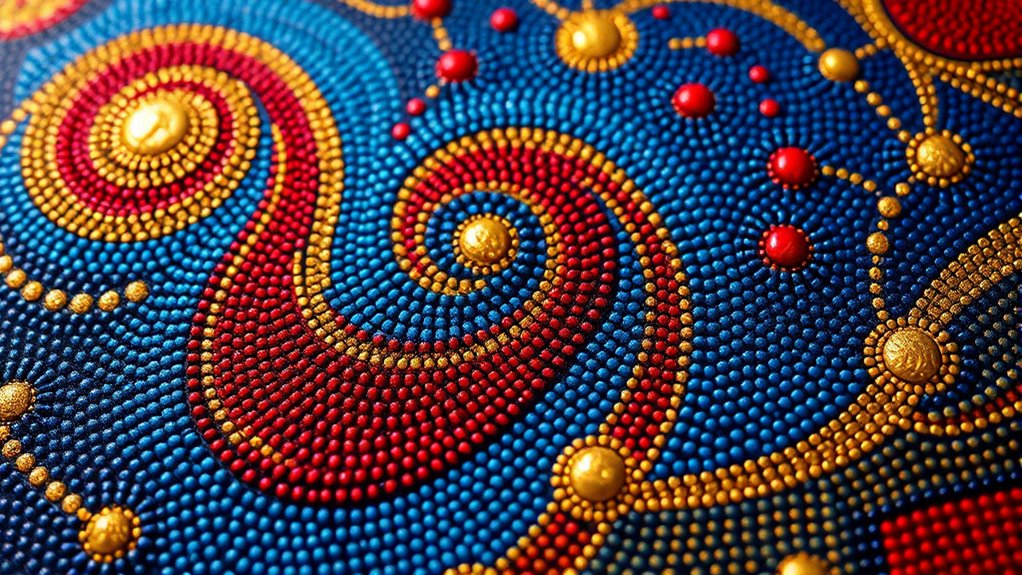
Have you ever wondered what stories and meanings lie behind the intricate patterns of dot painting? This art form isn’t just about placing dots randomly; it’s a language that carries deep symbolism and cultural significance. Each pattern, color, and arrangement reflects stories, spiritual beliefs, and connections to the land. When you look closely, you see that the symbolism meanings embedded in dot painting aren’t arbitrary—they’re rooted in centuries of tradition. For Indigenous Australians, dot paintings serve as a visual language that encodes Dreamtime stories, ancestral journeys, and sacred sites. The dots themselves often symbolize elements like stars, footprints, or waterholes, depending on the narrative being conveyed. Understanding these symbolism meanings transforms a simple artwork into a storytelling device, allowing you to connect with the cultural heritage behind it. Over time, the technique evolution of dot painting has played a pivotal role in its development and global recognition. Originally, these paintings were created using natural pigments on rock surfaces or bark, with artists meticulously applying tiny dots to depict sacred stories. As the art form gained popularity, artists began experimenting with different tools and mediums, shifting from traditional natural pigments to acrylic paints on canvas. This evolution not only made the process more accessible but also expanded the range of colors and textures available, allowing artists to express themselves more vividly. Today, many artists blend traditional methods with contemporary styles, pushing the boundaries of what dot painting can represent. This technique development reflects a dynamic balance between preserving cultural heritage and innovating for modern audiences. As you explore dot paintings, you’ll notice the meticulous detail and rhythmic patterns that highlight the artist’s skill and cultural connection. The dots are often applied with tools like sticks, brushes, or even fingernails, each choice adding a unique texture and depth to the artwork. Recognizing how the technique has evolved and understanding the symbolism meanings behind the patterns deepens your appreciation for this art form. It’s not merely decorative; it’s a profound narrative woven through layers of history, spirituality, and cultural identity. When you stand before a dot painting, you’re witnessing a visual storybook, where every dot and color has a purpose. Appreciating the intricate technique and symbolism allows you to see beyond the surface, uncovering stories passed down through generations. Ultimately, dot painting is a vibrant dialogue between tradition and innovation, a tribute to the enduring power of cultural storytelling expressed through simple yet profound artistic techniques. Exploring the evolution of techniques further reveals how artists adapt traditional methods to contemporary contexts, enriching the art form’s expressive potential.
Frequently Asked Questions
How Do Different Indigenous Communities Interpret Dot Painting Symbols?
You might wonder how indigenous communities interpret dot painting symbols. Each community assigns unique symbolic meanings to their designs, often representing landscape features, Dreamtime stories, or community histories. By understanding these symbols, you gain insight into their cultural narratives and community representations. Recognizing the diversity in interpretations helps you appreciate the depth and significance behind each dot painting, beyond just the visual appeal, revealing the rich cultural stories woven into every pattern.
What Materials Are Best for Creating Durable Dot Paintings?
To create durable dot paintings, you should choose materials that stand the test of time. Use natural pigments for vibrant, lasting colors, and opt for high-quality, primed canvas to guarantee durability. Applying a clear sealant can protect your artwork from moisture and fading. This combination of natural pigments and sturdy canvas helps your dot paintings retain their beauty and integrity over the years, making your art both vibrant and long-lasting.
Can Dot Painting Techniques Be Adapted for Digital Art?
You can definitely adapt dot painting techniques for digital art through digital adaptation and virtual techniques. By using graphic tablets and design software, you can mimic the dotting process, adjusting brush sizes and textures for authentic effects. This approach allows you to experiment with colors and patterns easily while maintaining the essence of traditional dot painting. Embrace digital tools to explore new creative possibilities without sacrificing the unique aesthetic of dot art.
How Do Color Choices Influence the Meaning of a Dot Painting?
You see how color choices shape the meaning of a dot painting by influencing its emotional impact and conveying color symbolism. Bright, warm hues evoke feelings of energy and happiness, while cool, muted tones suggest calmness or introspection. You actively select colors to communicate specific moods, tell stories, or honor cultural significance, knowing that every color enhances your artwork’s message and deepens viewers’ emotional connection.
Are There Specific Rituals or Traditions Associated With Creating Dot Paintings?
You might wonder if creating dot paintings involves specific rituals or traditions. Often, these artworks hold ceremonial significance and are deeply rooted in cultural rituals. You could observe traditional practices, such as performing specific gestures or using particular tools, to honor the cultural meaning behind the art. These rituals safeguard that the spiritual and cultural essence of the painting is preserved, making the process a meaningful act beyond mere decoration.
Conclusion
Now that you’ve uncovered the secrets behind dot painting, you realize it’s more than just dots—it’s a form of storytelling and self-expression. Think of it as your own personal Da Vinci sketchbook, where each dot holds meaning and history. So next time you pick up your brush, remember you’re joining a timeless tradition that’s as vibrant today as it was in the days of the Renaissance. Embrace the art, and let your creativity run wild!
